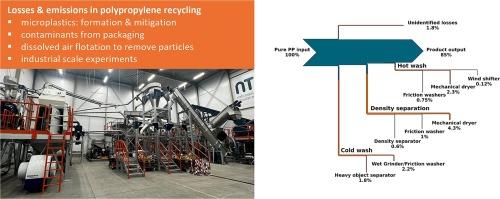Losses and emissions in polypropylene recycling from household packaging waste
IF 7.1
2区 环境科学与生态学
Q1 ENGINEERING, ENVIRONMENTAL
引用次数: 0
Abstract
In this study we replicated a typical high-quality post-consumer polypropylene (PP) recycling process to investigate its losses and emissions and study potential improvements. To our knowledge this is the first time that quantitative measurements on all process steps have been performed instead of an accumulated yield and emissions in water. In the process an overall PP yield of 85 wt% based on pure PP input is achieved. The loss of target material is largest at the two mechanical dryer steps (6.6 wt%) and in the wet grinder combined with friction washers (4.0 wt%). In the process we observed approx. 3.9 wt% of the PP input as microplastics in the wastewater before the dissolved air flotation unit which is capable of 97–99 % mass-based removal of microplastics (MPs). Around 330 µg of PP was emitted to air at the mechanical drying step for each kg of input material. This is a very low mass fraction, but considering the particle size distribution the number of particles is vast. This emission can be reduced by using air filters at locations where MPs are generated. To reduce losses and emissions we investigated a few potential process changes. Compared to current practice, positive results were achieved by ensuring that the knives of the wet grinder remain sharp. The mechanical drying process can be improved by lowering the centrifugal speed which reduces the generated microplastics here from 4 wt% to 1 wt% without significantly affecting the moisture content.

从家用包装废弃物中回收聚丙烯过程中的损耗和排放。
在这项研究中,我们复制了一个典型的高质量消费后聚丙烯(PP)回收工艺,以调查其损耗和排放情况,并研究潜在的改进措施。据我们所知,这是首次对所有工艺步骤进行定量测量,而不是累积产量和水中排放量。在该工艺中,基于纯 PP 输入的 PP 总产量达到 85 wt%。目标材料损失最大的是两个机械干燥步骤(6.6 wt%)和结合摩擦清洗机的湿法研磨机(4.0 wt%)。在此过程中,我们观察到废水中约有 3.9 wt%的聚丙烯以微塑料形式存在于溶气气浮装置中,该装置能够以质量为基础去除 97-99% 的微塑料 (MP)。在机械干燥步骤中,每公斤输入材料约有 330 微克的 PP 排放到空气中。虽然质量分数很低,但考虑到粒度分布,颗粒的数量是巨大的。在产生 MP 的位置使用空气过滤器可以减少这种排放。为了减少损失和排放,我们研究了一些潜在的工艺变化。与目前的做法相比,通过确保湿法研磨机的刀具保持锋利,可以取得积极的效果。机械干燥过程可以通过降低离心速度来改进,这样可以将产生的微塑料从 4 wt% 降低到 1 wt%,而不会对水分含量产生重大影响。
本文章由计算机程序翻译,如有差异,请以英文原文为准。
求助全文
约1分钟内获得全文
求助全文
来源期刊

Waste management
环境科学-工程:环境
CiteScore
15.60
自引率
6.20%
发文量
492
审稿时长
39 days
期刊介绍:
Waste Management is devoted to the presentation and discussion of information on solid wastes,it covers the entire lifecycle of solid. wastes.
Scope:
Addresses solid wastes in both industrialized and economically developing countries
Covers various types of solid wastes, including:
Municipal (e.g., residential, institutional, commercial, light industrial)
Agricultural
Special (e.g., C and D, healthcare, household hazardous wastes, sewage sludge)
 求助内容:
求助内容: 应助结果提醒方式:
应助结果提醒方式:


